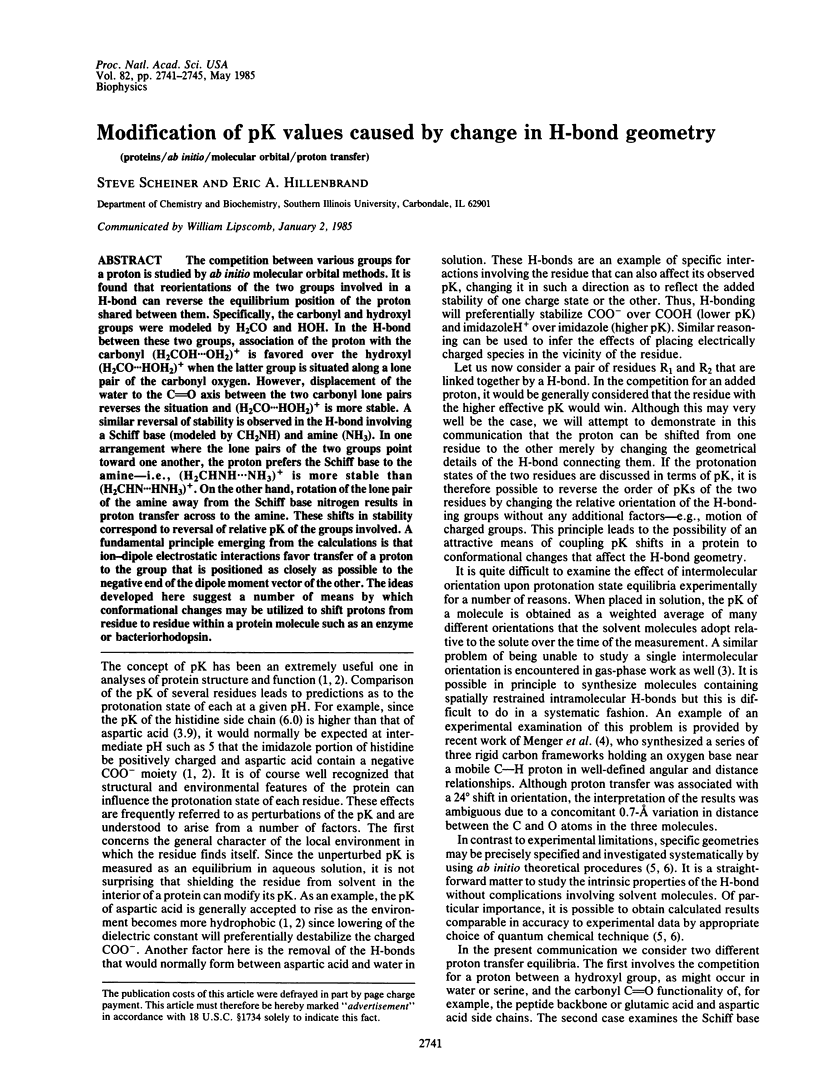Abstract
The competition between various groups for a proton is studied by ab initio molecular orbital methods. It is found that reorientations of the two groups involved in a H-bond can reverse the equilibrium position of the proton shared between them. Specifically, the carbonyl and hydroxyl groups were modeled by H2CO and HOH. In the H-bond between these two groups, association of the proton with the carbonyl (H2COH...OH2)+ is favored over the hydroxyl (H2CO...HOH2)+ when the latter group is situated along a lone pair of the carbonyl oxygen. However, displacement of the water to the C = O axis between the two carbonyl lone pairs reverses the situation and (H2CO...HOH2)+ is more stable. A similar reversal of stability is observed in the H-bond involving a Schiff base (modeled by CH2NH) and amine (NH3). In one arrangement where the lone pairs of the two groups point toward one another, the proton prefers the Schiff base to the amine--i.e., (H2CHNH...NH3)+ is more stable than (H2CHN...HNH3)+. On the other hand, rotation of the lone pair of the amine away from the Schiff base nitrogen results in proton transfer across to the amine. These shifts in stability correspond to reversal of relative pK of the groups involved. A fundamental principle emerging from the calculations is that ion-dipole electrostatic interactions favor transfer of a proton to the group that is positioned as closely as possible to the negative end of the dipole moment vector of the other. The ideas developed here suggest a number of means by which conformational changes may be utilized to shift protons from residue to residue within a protein molecule such as an enzyme or bacteriorhodopsin.
Full text
PDF




Selected References
These references are in PubMed. This may not be the complete list of references from this article.
- Bagley K., Dollinger G., Eisenstein L., Singh A. K., Zimányi L. Fourier transform infrared difference spectroscopy of bacteriorhodopsin and its photoproducts. Proc Natl Acad Sci U S A. 1982 Aug;79(16):4972–4976. doi: 10.1073/pnas.79.16.4972. [DOI] [PMC free article] [PubMed] [Google Scholar]
- Bayley H., Radhakrishnan R., Huang K. S., Khorana H. G. Light-driven proton translocation by bacteriorhodopsin reconstituted with the phenyl analog of retinal. J Biol Chem. 1981 Apr 25;256(8):3797–3801. [PubMed] [Google Scholar]
- Druckmann S., Ottolenghi M., Pande A., Pande J., Callender R. H. Acid-base equilibrium of the Schiff base in bacteriorhodopsin. Biochemistry. 1982 Sep 28;21(20):4953–4959. doi: 10.1021/bi00263a019. [DOI] [PubMed] [Google Scholar]
- Lemke H. D., Bergmeyer J., Straub J., Oesterhelt D. Reversible inhibition of the proton pump bacteriorhodopsin by modification of tyrosine 64. J Biol Chem. 1982 Aug 25;257(16):9384–9388. [PubMed] [Google Scholar]
- Lewis A., Marcus M. A., Ehrenberg B., Crespi H. Experimental evidence for secondary protein-chromophore interactions at the Schiff base linkage in bacteriorhodopsin: Molecular mechanism for proton pumping. Proc Natl Acad Sci U S A. 1978 Oct;75(10):4642–4646. doi: 10.1073/pnas.75.10.4642. [DOI] [PMC free article] [PubMed] [Google Scholar]
- Nagle J. F., Morowitz H. J. Molecular mechanisms for proton transport in membranes. Proc Natl Acad Sci U S A. 1978 Jan;75(1):298–302. doi: 10.1073/pnas.75.1.298. [DOI] [PMC free article] [PubMed] [Google Scholar]
- Nagle J. F., Tristram-Nagle S. Hydrogen bonded chain mechanisms for proton conduction and proton pumping. J Membr Biol. 1983;74(1):1–14. doi: 10.1007/BF01870590. [DOI] [PubMed] [Google Scholar]
- Rothschild K. J., Marrero H. Infrared evidence that the Schiff base of bacteriorhodopsin is protonated: bR570 and K intermediates. Proc Natl Acad Sci U S A. 1982 Jul;79(13):4045–4049. doi: 10.1073/pnas.79.13.4045. [DOI] [PMC free article] [PubMed] [Google Scholar]
- Silverman D. N., Vincent S. H. Proton transfer in the catalytic mechanism of carbonic anhydrase. CRC Crit Rev Biochem. 1983;14(3):207–255. doi: 10.3109/10409238309102794. [DOI] [PubMed] [Google Scholar]
- Smith S. O., Myers A. B., Pardoen J. A., Winkel C., Mulder P. P., Lugtenburg J., Mathies R. Determination of retinal Schiff base configuration in bacteriorhodopsin. Proc Natl Acad Sci U S A. 1984 Apr;81(7):2055–2059. doi: 10.1073/pnas.81.7.2055. [DOI] [PMC free article] [PubMed] [Google Scholar]
- Stoeckenius W., Bogomolni R. A. Bacteriorhodopsin and related pigments of halobacteria. Annu Rev Biochem. 1982;51:587–616. doi: 10.1146/annurev.bi.51.070182.003103. [DOI] [PubMed] [Google Scholar]


